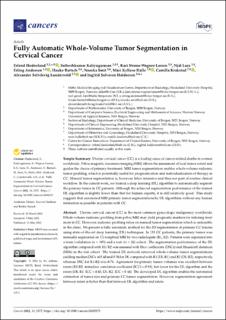Fully Automatic Whole-Volume Tumor Segmentation in Cervical Cancer
Hodneland, Erlend; Kaliyugarasan, Sathiesh Kumar; Wagner-Larsen, Kari Strøno; Lura, Njål Gjærde; Andersen, Erling; Bartsch, Hauke; Smit, Noeska Natasja; Halle, Mari Kyllesø; Krakstad, Camilla; Lundervold, Alexander Selvikvåg; Haldorsen, Ingfrid S.
Journal article, Peer reviewed
Published version

Åpne
Permanent lenke
https://hdl.handle.net/11250/3000609Utgivelsesdato
2022-05-11Metadata
Vis full innførselSamlinger
- Department of Mathematics [939]
- Registrations from Cristin [9791]
Sammendrag
Uterine cervical cancer (CC) is the most common gynecologic malignancy worldwide. Whole-volume radiomic profiling from pelvic MRI may yield prognostic markers for tailoring treatment in CC. However, radiomic profiling relies on manual tumor segmentation which is unfeasible in the clinic. We present a fully automatic method for the 3D segmentation of primary CC lesions using state-of-the-art deep learning (DL) techniques. In 131 CC patients, the primary tumor was manually segmented on T2-weighted MRI by two radiologists (R1, R2). Patients were separated into a train/validation (n = 105) and a test- (n = 26) cohort. The segmentation performance of the DL algorithm compared with R1/R2 was assessed with Dice coefficients (DSCs) and Hausdorff distances (HDs) in the test cohort. The trained DL network retrieved whole-volume tumor segmentations yielding median DSCs of 0.60 and 0.58 for DL compared with R1 (DL-R1) and R2 (DL-R2), respectively, whereas DSC for R1-R2 was 0.78. Agreement for primary tumor volumes was excellent between raters (R1-R2: intraclass correlation coefficient (ICC) = 0.93), but lower for the DL algorithm and the raters (DL-R1: ICC = 0.43; DL-R2: ICC = 0.44). The developed DL algorithm enables the automated estimation of tumor size and primary CC tumor segmentation. However, segmentation agreement between raters is better than that between DL algorithm and raters.
